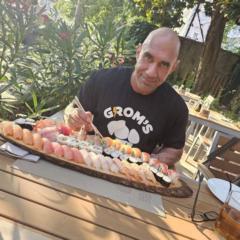Activity
Mon
Wed
Fri
Sun
Oct
Nov
Dec
Jan
Feb
Mar
Apr
May
Jun
Jul
Aug
Sep
What is this?
Less
More
Memberships
Light Skool
798 members • Free
Castore: Built to Adapt
310 members • Free
9 contributions to Castore: Built to Adapt
Kidney Article Part 5 — The Protocol
Stories are only as powerful as the actions they inspire. In the first part of this series, we followed the earliest domino of kidney disease back to the mitochondria, where stress piled up until adaptation became maladaptation. In the second part, we mapped out the signaling pathways the master switches of energy, growth, inflammation, and repair that tilt health toward decline when balance is lost. In the third part, we looked at the biomarkers, the fingerprints left behind by falling dominoes, and saw how they let us measure stress long before kidneys reach crisis. In the fourth part, we climbed the intervention pyramid, starting with the free but foundational acts of sleep and stress repair, moving through exercise and nutrition, and ending with advanced tools like peptides and devices. Now it’s time to bring everything together into a practical framework. Cellular medicine is not about chasing symptoms; it’s about restoring the cell’s ability to adapt. That means sequencing interventions in a way that stabilizes the base before layering in complexity. It means aligning choices with molecular mechanisms, so that every hour of sleep, every meal, every training session, and every carefully chosen compound feeds into the same theme: nudging mitochondria back into resilience, quieting maladaptive signals, and protecting the delicate sieves that filter our blood. Let’s imagine the cell not as a machine but as a city. The mitochondria are its power plants, the endothelial cells its bridges, the immune signals its alarm systems, and the sirtuins its seasoned repair crews. In kidney disease, the power plants are overloaded, the bridges are cracking, the alarms are stuck blaring, and the repair crews are underpaid and understaffed. Our goal is not to replace the city it’s to re-train it, re-fuel it, and restore harmony between its systems. The protocol that follows is built on four layers, like the pyramid described earlier. Each layer feeds into the next. Lifestyle calibrates the environment. Exercise builds capacity. Nutrition signals adaptation. Advanced tools accelerate resilience. None of these can work alone; together, they create synergy. And synergy is what the kidney, an organ of fine balance, requires. Here’s how it comes together in practice:
Supplements and Quality - When Brand/Source Matters and When It Doesn't
Here's another group project that I discussed with @Anthony Castore and we agreed having the group work on this together would allow us to receive the best input and put together the best reference list for us all to use. Because the supplement industry is both noisy and inconsistent the distinction between quality/efficacious supplements/compounds and those that are not is often times a very difficult task: some compounds are a commodity-like (creatine monohydrate, bulk amino acids), where purity is relatively easy to achieve and there’s little advantage paying extra for a “designer” label. Other categories — especially lipids (fish oil), fat-soluble antioxidants (CoQ10, carotenoids), or bioactives with low natural stability (PQQ, Urolithin A) — live or die by formulation, raw material source, and quality control. A couple principles that might help as we consider our list: 1. Is it chemically simple or complex? Creatine: single molecule, stable, easy to verify → brand doesn’t matter much if third-party tested. Fish oil, plasmalogens, 1-MNA: unstable lipids or niche molecules → form (TG vs EE vs PC-bound) and oxidation state matter a lot. 2. Does delivery change absorption? Ubiquinol vs Ubiquinone: redox state and carrier lipids improve bioavailability. Liposomal formulations can genuinely help poorly absorbed compounds, but not everything benefits. 3. Is there independent validation? Many of the “designer” claims for things like PQQ, Apigenin, Urolithin A aren’t well-backed by head-to-head human data. In these cases, the real differentiator is whether the company does third-party testing for purity, heavy metals, and stability. 4. Follow the raw material suppliers. Most of the industry is built on the same raw material suppliers (for example, Kaneka for CoQ10, Mitopure for Urolithin A). If a product sources from a top supplier, you’re usually getting the same active regardless of label. The “Amazon brands” like Nutricost or Toniiq can be perfectly fine when they disclose sourcing and batch testing.
Cerebrolysin for healty brain
Cerebrolysin for better brain function — has anyone tested it, and what are the recommended dosages and protocols?
Stem Cell Therapy and Complimentary Peptides/Supplements
I’ve got a client headed for the first of a series of stem cell injections to address an old ACL injury. He’s already on the BPC-157 track, but curious about a more nuanced/thoughtful post procedure support/healing protocols, esp timing/sequencing and phasing. Appreciate your thoughts and experiences.
4 likes • Aug 18
Hey Jessica! I would absolutely stack bpc with tb500 and ghk-cu, simply because for healing purposes I believe they synergise perfectly. In higher doses I think ghk-cu may possibly even help with endogenous stem cell mobilisation? @Anthony Castore Is this actually the case? However, if the stem cell transplant is autologous(from the client's own cells) it may not be the best idea to mobilise them before treatment due to fact the cells would need to be harvested with liposuction from adipose tissue or bone marrow which is where the largest amount of stem cells reside in our bodies, I believe. However, certainly post treatment would be fine. I would also suggest that growth hormone peptides could play a strong role alongside the aforementioned peptide therapeutics post treatment. I would probably add targeted red light therapy(I use a Kineon Move pro) which I feel would complement a structured healing protocol and potentially also a hyperbaric chamber too if your client can access one. Other products I have heard of being utilised for pre and post stem cell treatments include StemRegen Release and bioregulators chosen specificically for the targeted area/s or systems, dependant on whether the treatment is delivered intra-articularly or systemically😊🙏
Glucose disposable and ampk activation with Metformin
Hi guys! I am considering using Metformin for overall wellbeing, glucose disposal and longevity. I am aware there are possibly other benefits to this such as positive effects on the Thymus gland and activating ampk? Is this correct? Looking at this from the refreshing no "bro science" angle, which massively attracted me to this group, is there a duality to this approach and anything to consider before starting such a protocol? Is there a downside? Alternatives such Jardiance or Berberine derivatives? Or a stack to potentiate or synergise? Any info on this or other people's experiences with regard to understanding the mechanisms involved would be so welcome. Thanks in advance! Excited to be here😊🙏
1-9 of 9
@dave-olphert-8969
Absolutely excited to learn. Relatively new to this stuff. Passionate about positive change and applying theory and science for optimisation
Active 2h ago
Joined Aug 1, 2025
Powered by





